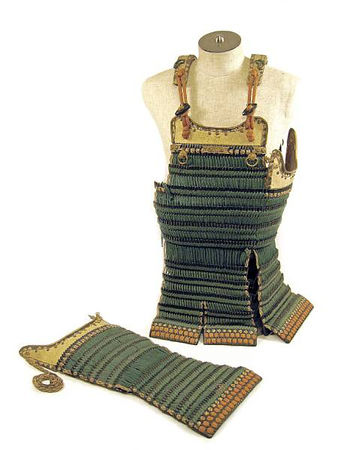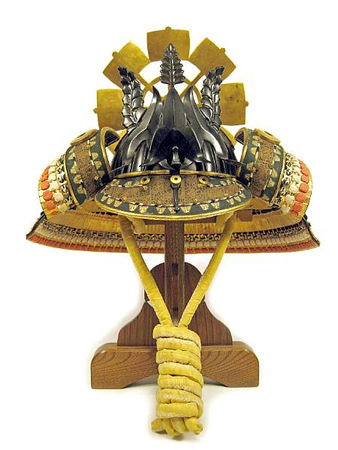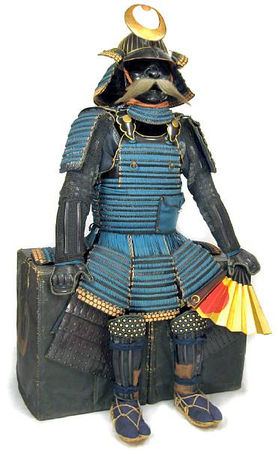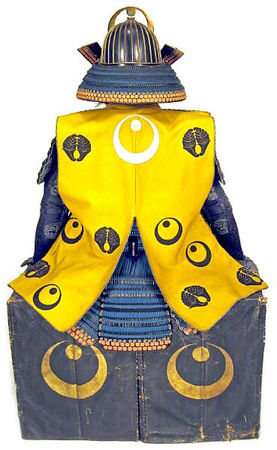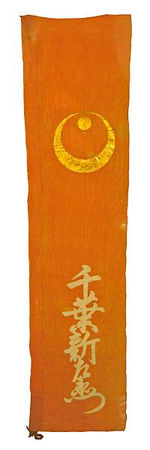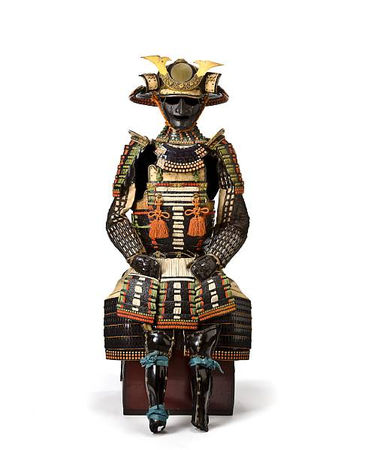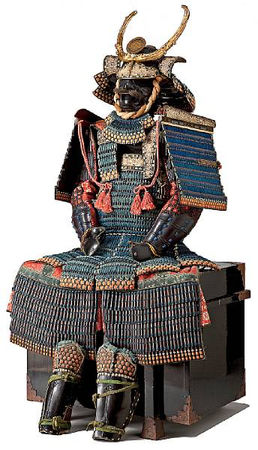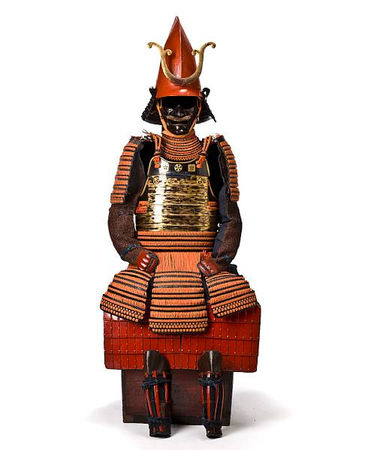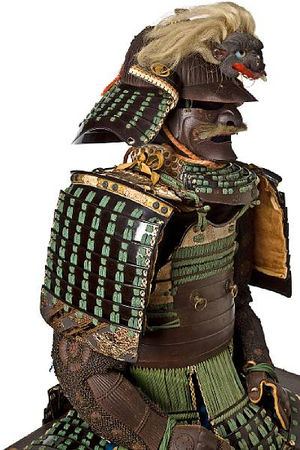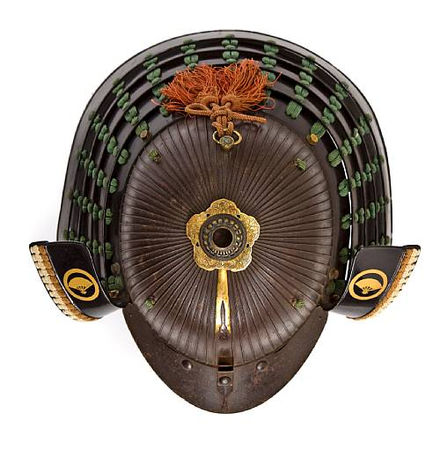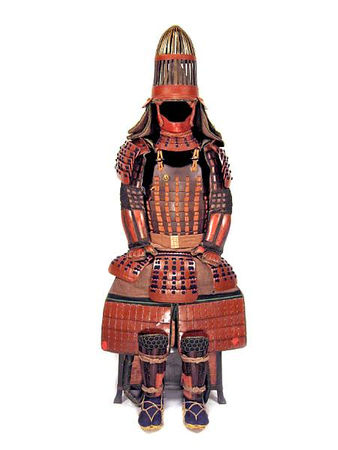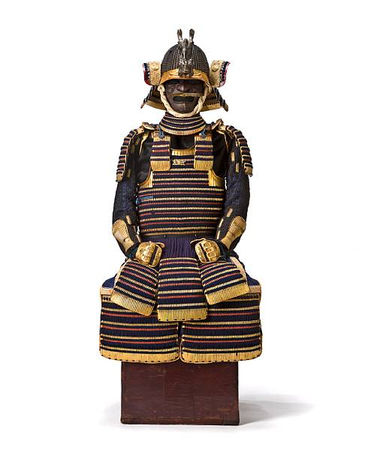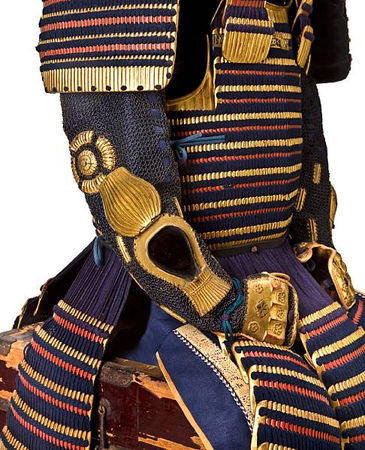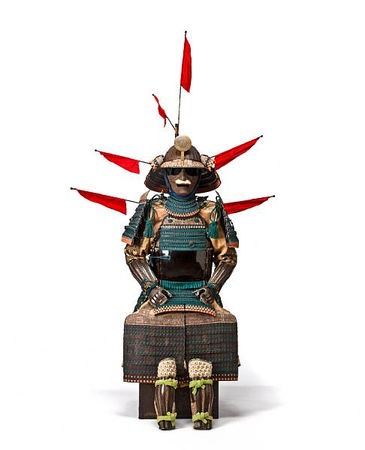Armor of the monk Tenkai, with kirin crest, buffalo horns, and large crescent moon back ornament. Japan, Edo period, early 1600s
An o-yoroi armor, Late Edo period (19th century) © 2002-2009 Bonhams 1793 Ltd
The armor of honkozane lacquered black and laced in green kebiki odoshi and mounted with gilt-copper hardware and comprising a forty-six plate suji bachi lacquered black with a large four-lame omanju jikoro, fukigaeshi and mabisashi, all applied with stenciled doe skin, the front of the bowl fitted with a gilt-copper kuwagata dai holding kuwagata and a large gold-lacquered wood dragon maedate; the black-lacquered iron yoshi ryubumen fitted with a three-lame yodarekake; the do of unusual construction with a tsuboita plate not of the usual solid metal but rather constructed of honkozane, matching the cuirass, fitted with sendan and kyubi no ita; osode; kawara haidate; russet-iron tsutsu gote and suneate; with two wood storage boxes – Sold for $51,850
A suit of armor with a myochin-school helmet and a hishi toji ni-mai do. Helmet bowl by Myochin Yoshimichi, late Muromachi period, 16th century, armor mid-Edo period (18th century) © 2002-2009 Bonhams 1793 Ltd
Comprising a fine sixty-two plate russet-iron suji bachi, signed Myochin Yoshimichi, mounted with a five-lame komanju jikoro of kiritsuke kozane, the fukigaeshi and mabisashi trimmed with “rope” fukurin in shakudo, a shakudo crest on the fukigaeshi is repeated in three places of the hishinui no ita, the simple maedate of a circle and on either side of the helmet a black-lacquer wakidate of wisteria flowers; russet-iron menpo applied with a boar’s hair mustache, the kosode laced in bands of blue, yellow, white and mauve; the cuirass a nimai okegawa hishi toji do with hinged gourd-shaped gyoyo, the right side hinged to open independently, laced in dark blue kebiki odoshi lacing over black lacquer; tsubo gote and shino suneate russet-iron splashed with sawari; kawara haidate; one armor box. Sold for $48,800
With a Tokubetusu Kicho certificate issued by the Nihon Bugu Katchu Kenkyu Hozan Kai (Society for the preservation of Japanese armor)
A black-lacquer nerigawa suit of armor, Edo period (19th century) © 2002-2009 Bonhams 1793 Ltd
Comprising a twenty-four plate suji kabuto lacquered black and embellished with shakudo nanako shinodare constructed of several plates, the top of the bowl fitted with a bold six-stage shakudo and gold chrysanthemum tehen kanamono carved with vines and a nanako ground, the bowl fitted with a four-lame omanju jikoro lacquered black and laced in dark blue, orange and white kebiki odoshi, the interior gold lacquer, the mabisashi and large fukigaeshi decorated with stenciled doe skin and silk cords and lined with gilt-copper fukurin, gilt-copper sanko no byo, and gold-lacquer circular family crests of the Kuroda family, the front of the bowl fitted with a black-lacquered wood water plantain maedate, and an additional wood demon-maedate applied with flowing yak’s hair and a gold-lacquered wood water-wheel ushirodate; black-lacquered iron hanbo with a five-lame yodarekake; the nimai yokohagi do lacquered leather and mounted with gilt-copper hardware, fitted with seven sections of five-lame kusazari with the bottom lame trimmed in black yak fur; chusode; Bishamon gote; haidate of kozane; shino suneate; waraji; with two wood storage boxes – Sold for $39,650
A suit of armor with a ni-mai tachi do and accoutrements. Helmet bowl Muromachi period (16th century), armor late Edo period (19th century) © 2002-2009 Bonhams 1793 Ltd
Comprising a thirty-two plate iron suji kabuto lacquered black and mounted with gilt-copper fukurin, the maedate and small fukigaeshi lacquered to match the bowl, mounted with a shakudo kuwagata dai and a gilt-copper kuwagata surrounding a circular ring maedate, the bowl fitted with a komanju shikoro; the Ressei menpo lacquered black and fitted with a five-lame yodarekake applied with a boar-bristle mustache; the ni-mai tachi do constructed of kiritsuke kozane lacquered black and laced in blue kebiki odoshi lacing, with black-lacquer gyoyo, ukezutsu and applied with a tsuru bukuro on the front; kosode; shino gote; karuta gane haidate and shino suneate; with a fine jinbaori war vest of yellow “Dutch” fabric with a family crest on the front and back, a war fan, a red-silk sashimono with a gold family crest and white inscription, and a campaign curtain; with two wood storage boxes with leather covers – Sold for $39,650
A suit of armor with a myochin-school helmet and a hishi toji ni-mai do. Helmet attributed to Muneyasu (Myochin Muneyasu), Muromachi period, 15th-16th century, armor Edo period (18th century) © 2002-2009 Bonhams 1793 Ltd
The suit constructed of lacquered-leather scales and elegantly laced in white, green and orange in vertical configuration, comprising a sixteen-plate russet-iron suji kabuto constructed of broad plates worked on the surface to a rough texture, the flanges fitted with gilt-copper fukurin and surmounted by a four-stage gilt-copper tehen kanamono, the mabisashi applied with stenciled doe skin, trimmed in gilt-metal fukurin and fitted with gilt-metal kuwagata dai pierce carved with chrysanthemums and floral scroll and supporting a gilt-metal kuwagata and a large disc maedate, the bowl fitted with a wide three-lame omanju jikoro and a full fukigaeshi applied with stenciled doe skin and gilt-metal family crests; the menpo with deep wrinkles and a prominent chin, the cheeks with yadome and lacquered black in a striated-pattern finish, boar-bristle mustache, the mask with a five-lame hinged yodarekake; the do-maru lacquered with a “stone finish” mounted with gilt-copper hardware, some of it carved with paulownia crests on a nanako ground, the munaita applied with stenciled doe skin decorated with the Sanskrit character for Fudo Myo-o, the wakiita applied with gilt leather, seven sections of four-lame kusazari; two-lame nodawa; tsubo sode applied with gilt-metal kanmuri no ita; shino gote; kawara haidate; tsubo suneate; two wood storage boxes decorated with family crests. Sold for $36,600
With an attestation paper attributing the helmet to Myochin Muneyasu, signed Myochin Munekatsu and dated 1724
An o-yoroi-style suit of armor, 18th century © 2002-2009 Bonhams 1793 Ltd
Black-lacquered leather honkozane armor laced entirely in blue with orange trim, comprising a thirty-two-plate suji kabuto lacquered matte-black with the ridges lacquered glossy-black, the top of the bowl fitted with a large four-stage chrysanthemum tehen kanemono, fitted with a wide manju-style three-lame neck guard, the top lame terminating in large turnbacks applied with stenciled doe skin with metal cherry-floret family crests, the peak decorated to match, the gold-lacquer kuwagata designed with crashing waves and the maedate, a circular medallion with cherry-floret family crest; the face mask black-lacquered iron, applied with a boar’s hair mustache and fitted with a two-lame bib-style throat guard; the cuirass applied with stenciled doe skin on the munaita, wakiita and oshitsuke no ita, with sendan no ita and kyubi no ita, cuirass fitted with eight sections of five-lame tassets; osode; tsutsugote with lacquered iron plates; kawara haidate; tsutsu suneate; one armor box – Sold for $31,720
A black, gold and red-lacquer armor with a kawari kabuto, Edo period (17th-18th century) © 2002-2009 Bonhams 1793 Ltd
Laced in red and blue, comprising a kawari kabuto designed as a tall court cap (naga eboshi) with vertical striations and a slight “fold” at the back, fitted with a five-lame black-lacquer shikoro laced in kebiki style, the small fukigaeshi unadorned, the front mounted with a gold-lacquered wood bracken-fern maedate; the black-lacquer menpo with deep wrinkles, gold-lacquer teeth and red lips, applied with a boar-bristle mustache, the mask fitted with a four-lame yodarekake; the yokohagi nimai do lacquered gold and black in a mottled pattern, the munaita with a hinge and decorated with gilt-metal family crests, the lower section of the curiass with kebiki-laced scales, fitted with seven sections of five-lame kusazari; with chusode and red-lacquer chain mail gote with sparse ikada; kawara haidate; shino suneate; one armor box – Sold for $30,500
A green-laced suit of armor with a russet-iron cuirass. Helmet by Masamoto, Edo period, 18th century © 2002-2009 Bonhams 1793 Ltd
Comprising a sixty-two plate iron suji kabuto, signed Kurume ju Masamoto, lacquered black, the bowl surmounted with a four-stage chrysanthemum tehen kanamono and fitted with a five-stage Hineno-style ita mono jikoro; the menpo russt-iron with a five-lame yodarekake, shino gote sleeves with applied shigami decorations and demon masks with gilt eyes and family crests with gilt ground, the front of the helmet mounted with a large demon forecrest rendered in wood and lacquer with applied yak fur, the eyes of Edo glass; the cuirass a russet-iron yokohagi nimai do with the top section laced in kebiki style, the munaita and wakiita applied with stenciled doe skin, the do applied with seven sections of five-lame solid-plate kusazari lacquered black, the bottom lame laced in pale and dark orange; chusode; shin gote sleeves with applied shigami decorations; kawara haidate; tsutsu suneate; war fan; two armor boxes decorated with family crests – Sold for $27,450
An armor with a kawari kabuto helmet in the form of a bird cage (torikago). Momoyama-early Edo period (late 16th-early 17th century) © 2002-2009 Bonhams 1793 Ltd
The suit lacquered red and silver, laced in red with dark blue highlights and comprising an extraordinary helmet designed as a bird cage, the conical bowl overlaid with a tall, red-lacquered iron rim with the mabisashi attached to the front, rising from this rim are a series of vertical bands of whale bone forming a cage, supported halfway up by a second iron ring, the top of the cage mounted with a five-stage gilt-copper, shakudo and red-lacquer tehen kanamono from which emanates a topknot of white yak fur, the bowl fitted with a single-plate shikoro lacquered red beneath which is a double layer of padded cloth; the hanbo fitted with a four-lame yodarekake; the cuirass a mogami do fitted with seven sections of five-lame kusazari; chusode; shino gote; shino suneate; waraji; one wood storage box – Sold for $26,840
A black-lacquer armor with a yokohagi okegawa do, 18th-19th century © 2002-2009 Bonhams 1793 Ltd
The suit lacquered black and embellished with gold-lacquer paulownia crests on the components and laced in blue with orange highlights, comprising a sixty-two plate suji kabuto surmounted with a four-stage gilt and shakudo chrysanthemum tehen kanamono, the bowl fitted with a five-lame solid-plate shikoro, the sides of the helmet designed without the usual fukigaeshi and mounted with cylindrical mounts for wakidate, the edges trimmed in silver fukurin, the wood wakidate formed as demon’s ears lacquered silver with Sanskrit characters in black lacquer; the lacquered iron menpo with a hinged nose piece and decorated on the surface with a silver-lacquer chin tuft and designs embellishing the contours of the mask; the cuirass a yokohagi okegawa do with the lower section laced in kebiki in a dangae fashion, fitted with seven sections of five-lame kusazari, the munaita laced in kebiki, the edges all trimmed in silver fukurin, a storage pocket fitted to the left front of the cuirass; chusode and odagote; kiko haidate and tsutsu suneate; one armor box with matching paulownia crest – Sold for $23,180
A gold-lacquer suit of armor, Edo period (18th century) © 2002-2009 Bonhams 1793 Ltd
The suit constructed of honkozane and laced in blue and red keibiki odoshi and comprising an iron sixty-two plate koboshi kabuto, mounted with a five-stage gilt copper tehen kanamono, the mabisashi lacquered gold and mounted with a lacquered wood rabbit maedate, the bowl fitted with a five-lame Hineno-style shikoro, the fukigaeshi applied with stenciled doe skin and gilt copper circular heraldic plum blossom crests; russet-lacquer face mask applied with boar-bristle mustache and chin tuft and fitted with a four-lame yodarekake; the cuirass, a hatomune do with seven sets of five-lame kusazari and rectangular gyoyo, with pierce carved gilt-metal hardware; chusode; oda gote with hinged compartments on the gourd plates; haidate of honkozane; no suneate; one wood storage box – Sold for $23,180
A black-lacquer armor with a kawari kabuto, Edo period (18th century) © 2002-2009 Bonhams 1793 Ltd
The armor laced in dark blue with white highlights and comprising an eccentrically shaped helmet designed as a hood (zukin), the bowl fitted with a five-lame solid-plate shikoro the interior lacquered gold with the top lame terminating in small fukigaeshi; the menpo with a hinged nose piece and applied with a bushy yak-hair mustache; the cuirass a lacquered iron gomai yuki no shita do fitted with seven sections of five-lame solid-plate kusazari, the watagami protected by gyoyo, interior of cuirass gold lacquer; tosei sode mounted above shino gote; kawara haidate and tsubo suneate; with a war fan and one armor box – Sold for $23,180
A suit of armor with a haruta-school helmet and an okegawa do, Helmet by Haruta Tokimune, Edo period, 18th century © 2002-2009 Bonhams 1793 Ltd
The russet-iron armor laced in dark blue and orange with the components lacquered black and comprising a momonari kabuto mounted with a five-lame shikoro with small fukigaeshi, the front mounted with a circular gold-lacquer maedate and the sides of the bowl with large black-lacquered wood horns, signed on the interior of the bowl Haruta Tokimune; black-lacquer menpo fitted with four-lame yodarekake; go-mai yokohagi okegawa do with horizontally scalloped plates and a medial ridge, the munaita lacquered black and laced in blue and fitted with a gilt-copper ring, seven sections of five-lame kusazari; tsubosode; shinogote with floret bosses on the forearms; chain mail and plate haidate; shino suneate matching the kote; one wood storage box – Sold for $21,960
A blue-laced suit of armor with a go-mai do, Edo period (18th-19th century) © 2002-2009 Bonhams 1793 Ltd
Comprising a thirty-two plate russet-iron suji kabuto of dome shape mounted with four-stage mixed metal tehen kanamono, the mabisashi and fukigaeshi applied with stenciled doe skin and fitted with a gilt-copper tonbo jiri carved with floral scrolls and attached with a cherry floret boss and a gilt-copper disc maedate carved with a plum crest, the bowl fitted with a four-lame shikoro the bottom two lames terminating at different intervals and the top lame turning back to wide fukigaeshi applied with copper crests of the Hanabusa clan; russet-iron menpo applied with a white mustache of boar’s fur and fitted with a four-lame yodarekake; the go-mai do a hybrid of honkozane scales laced in keibiki hodoshi at the top and a black-lacquer Hotoke do at the bottom, the munaita decorated with stenciled doe skin, the reverse with a holder for sashimono consisting of six independent red flags, fitted with four sections of broad five-lame honkozane kusazari, the lowest lame split into two sections; osode with stenciled doe skin on the kanmuriita; shinogote with cherry blossom plates on the elbows; kawara haidate; shino suneate; one wood storage box – Sold for $19,520
Provenance: Hanabusa Family, by repute
Following the battle of Sekigahara in 1600, Takamatsu Castle came under the control of the Hanabusa clan. In recognition of their participation, Tokugawa Ieyasu rewarded the Hanabusa clan with land and elevated status, after which they became among the most trusted of the Tokugawa retainers.
A gold-lacquer armor, Edo period (18th-19th century) © 2002-2009 Bonhams 1793 Ltd
The scales lacquered gold and the suit laced in green and comprising a suji kabuto lacquered black and mounted with a four-stage chrysanthemum tehen kanamono and a five-lame neck guard, the top lame terminating in turnbacks finished with applied stenciled doe skin, fukurin and paulownia family crests, the front of the bowl adorned with kuwagata dai carved with chrysanthemum scroll and fitted with kuwagata and a gold-lacquered wood dragon maedate; face mask lacquered russet brown with red lips and applied with a boar’s bristle mustache and chin tuft, fitted with a four-lame throat guard; the cuirass honkozane do maru with six sets of five-lame tassets and applied with two cord rings; chusode; black-lacquer shino gote adorned with gourd-shaped plates on the upper arms; black-lacquer Etchu haidate and shino suneate; one armor box – Sold for $11,590
Related Post
A shocking documentary proves that mermaids do exist
SHOCKING Revelation: Thuya, Mother of Queen Tiye, Was the Grandmother of Akhenaten and Tutankhamun—What Ancient Egyptian Secrets Did She Leave Behind?
Breaking News: Astonishing Discoveries at Karahan Tepe Confirm an Extraterrestrial Civilization is Hiding on Earth, and NO ONE Knows!
Breaking News: Researchers FINALLY Discover U.S. Navy Flight 19 After 75 Years Lost in the Bermuda Triangle!
NASA’s Secret Investigation: Uncovering the Astonishing Mystery of the UFO Crash on the Mountain!
Explosive UFO Docs LEAKED: Startling Proof That Aliens Ruled Ancient Egypt!

